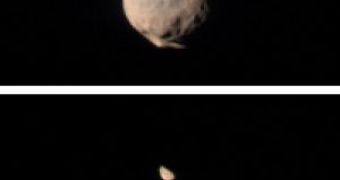Unlike our planet Earth which has a single large moon, Mars, our red neighbor, has two small asteroids that act as moons: Phobos and Deimos, in low orbit around the planet. Recent survey of the two asteroids, made by the Compact Reconnaissance Imaging Spectrometer, while on the night side of the planet reveals their chemical composition.
Asteroid Phobos has a diameter of 21 kilometers and an orbit of 7 hours and 39 minutes, while Deimos is only 12 kilometers across and orbits the Red Planet once every one day and 6 hours. As a result, on the short orbit time of the asteroid Phobos, to an observer on the surface of Mars it would appear that it rises from the west end of the planet and it is set to the east; it would have the appearance of about one-third of the surface of our Moon seen from the surface of the Earth, while the small asteroid Deimos would appear on the Martian night sky as a bright star.
Both were discovered in 1877, by the American astronomer Asaph Hall and were named after Greek mythological gods or figures that represented fear and terror.
The pictures taken by the Compact Reconnaissance Imaging Spectrometer on the 22nd of October, respectively on the 7th of June this year, display 544 colors and show details as small as 400 meters on the surface of Phobos, respectively 1.3 kilometers on Deimos, which have been doubled in size for viewing purposes.
The first spacecraft ever to make measurements of the surface of Mars and of its two companions was Mariner 9, during its mission from 1971 to 1972, followed shortly by the Viking Orbiter in 1975; it showed that both asteroids around the orbit of the red planet present dark reflective surfaces, which radiate about 5 to 7 percent of the total sunlight they receive. Due to this aspect, the construction of the reflected light spectrum proved to be difficult, even though it has been made with three completely different instruments.
The light spectroscopy analysis has revealed that the surface presented a flat, grayish spectrum, very similar to the chondrite meteorites, containing traces of carbon materials, which are thought to originate from the far region of the asteroid belt. This aspect led to the conclusion that Mars' primitive moons might have been captured by its gravity and put into an orbit around the planet in its early life.
They have been classified as D-type asteroids, similar to those present in the outer regions of the solar system, as a result of the most recent measurements that suggest that they are actually red in color. D-type asteroids are thought to contain high amounts of carbon and water in the form of ice and to have been subjected to less geochemical processes than most of the asteroids, which present carbonaceous condrites in their composition.
CRISM was able to take pictures in the red, green and blue wavelength of the light spectrum that have larger ranges on the human eye, and also accentuate color differences. Both moons are red-colored; however, Phobos' surface shows intrusion of a second material, thought to be ejected from a 9-kilometer diameter crater, created by a collision that would have normally pulverized an object that size. The crater, named Stickney, is located somewhere in the upper left limb of Phobos as seen in the image, and the debris material extends from it, towards the lower right of the asteroid.
Spectroscopy measurements on the surface of Deimos and of Phobos have been able to detect the presence of several chemical elements and substances, such as iron, water, and certain minerals containing high amounts of carbon. The Mars Reconnaissance Orbiter contains some other five science instruments, except the CRISM led by the Johns Hopkins University Applied Physics Laboratory. The main goal of the CRISM instrument aboard the orbiter is to find aqueous and hydrothermal deposits and to make a geological map of the asteroids, plus to determine their composition and the stratigraphy of the visible surface features. It is also designed to observe the variations of dust and aerosols in Mars' atmosphere, according to the seasons.

 14 DAY TRIAL //
14 DAY TRIAL //